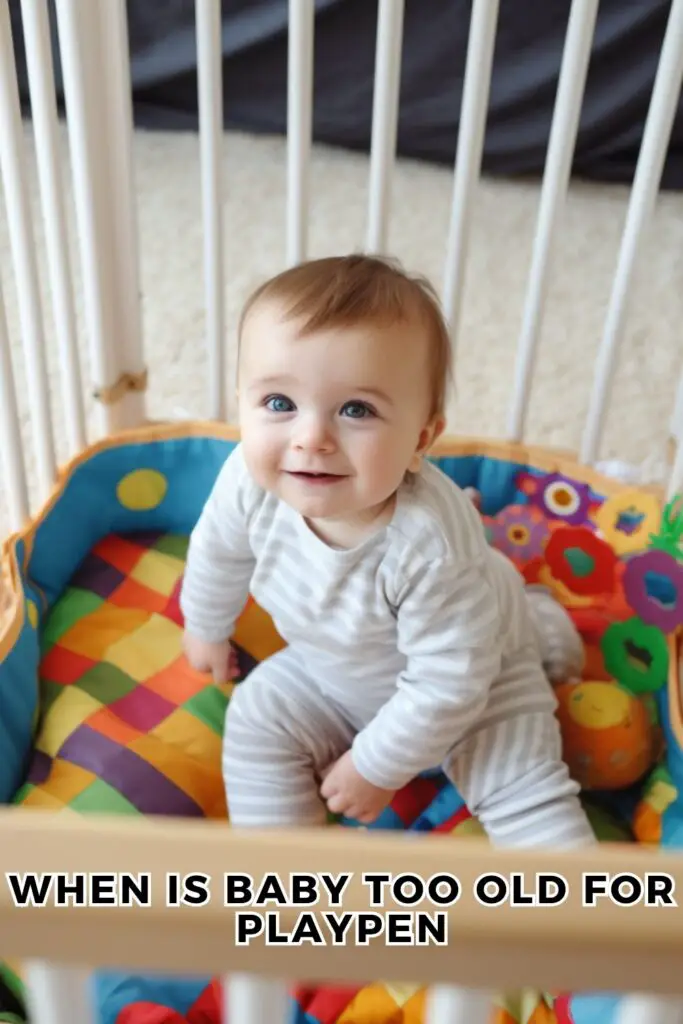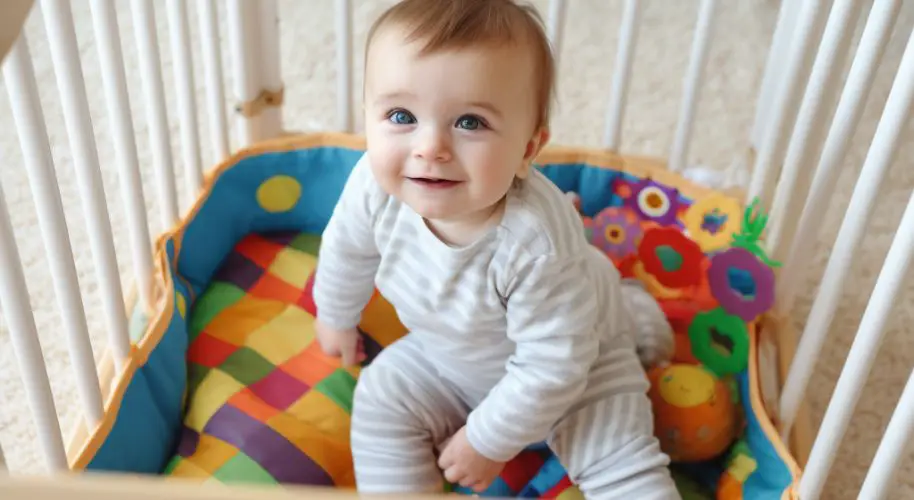Last Updated on June 5, 2025
A playpen can be a haven for your little one to play and explore without risk. However, as your baby grows and their mobility and curiosity increase, you may wonder when to say goodbye to the playpen.
Generally, around 2 to 3 years, toddlers exhibit increased curiosity and motor skills, often indicating a readiness to explore their surroundings more independently. They may have outgrown the playpen’s confines at this stage and could benefit from a more open and stimulating environment.
However, each child is unique, and factors such as safety, developmental progress, and individual temperament should guide this decision. As the baby becomes more adept at walking, climbing, and interacting, parents can gradually introduce new spaces for supervised exploration, fostering their cognitive and physical development.

When Is a Baby Too Old for Playpens?
Generally, playpens are most suitable for infants and toddlers aged 6 months to around 2-3 years. During the initial stages, playpens provide a secure space for babies to explore and practice motor skills. As they grow, however, their curiosity and physical abilities increase, prompting a need for more extensive exploration.
Around 2-3 years, children often outgrow the playpen’s limited space and require more room for movement and learning. At this point, it’s advisable to gradually transition them to a larger play area or childproofed rooms where they can move freely under supervision. Observing your child’s readiness to climb, walk, and interact with their surroundings helps determine when to discontinue playpen use.
On the other hand, playpens can be particularly useful when a child is just beginning to crawl, which typically happens at about six or seven months. At this stage, a playpen can provide a safe and confined space for the baby to move around without getting hurt.
The decision to stop using a playpen should also consider other factors, such as the child’s development and the family’s living situation. For example, if your home is not baby-proofed or if you have pets, you should use a playpen longer.
After the Playpen: Exploring the Next Stage
The stage after the playpen is a significant milestone in your child’s development. It signifies the commencement of their exploration of the world on a broader scale. This phase can be thrilling but also requires cautious preparation and guidance. Here are some tips to help you handle this transition:
1. Home Safety
Now that your child has more freedom to move around, it’s crucial to childproof your home. Secure furniture, cover sharp corners and install gates to limit access to potentially hazardous areas.
2. Encourage Curiosity
Your child’s curiosity will be their greatest teacher at this stage. Foster this by creating a safe space filled with toys, books, and activities that stimulate their senses and intellect.
3. Promote Independence
Encourage your child to perform simple tasks independently. This could include picking up toys or feeding themselves. These tasks will foster a sense of responsibility and independence.
4. Social Interactions
Facilitate social interactions with peers. Playdates or group activities can help your child develop essential social skills and understand the concept of sharing and teamwork.
5. Learning through Play
Use playtime as a learning opportunity. Educational toys, puzzles, and storybooks can enhance cognitive development, language skills, and problem-solving abilities.
Remember, each child grows at their own pace, so it’s important not to rush this process. Take the time to observe and enjoy this special phase of your child’s life, supporting them as they explore the world around them.
You Might also Like These Resources!
- Playpen Age Range: When Is It Suitable? Baby’s Playpen Age Limits
- Playpen Age Range: When Is It Suitable? Baby’s Playpen Age Limits
- Baby Formula Temperature: Is Cold Formula Safe?
Unveiling the Playpen: Its Pros and Cons

A playpen can be a parent’s best friend, offering a safe place for a child to play. But like any tool, it has its advantages and drawbacks. Let’s explore their benefits and potential downsides.
Pros of Using a Playpen
1. Safety: Playpens provide babies with a safe and secure space to play. They help protect infants from crawling around spaces where they could fall and injure themselves.
2. Portability: Playpens are easier to fold and pack than cribs. You can set them up in the living room during the day and move them around the house as needed.
3. Controlled Environment: A playpen prevents your baby from eating different things at home or inserting fingers in unwanted places.
4. Independent Play: Playpens allow babies to have their own space for play and exploration.
Cons of Using a Playpen
1. Emotional Isolation: Some argue that playpens could harm a baby’s emotional development due to feelings of isolation.
2. Restriction of Freedom: Critics of playpens argue that they restrict a baby’s freedom and limit their ability to explore their surroundings.
3. Developmental Concerns: While there’s no specific research about babies’ development and playpens, being alone and isolated is not beneficial for a baby’s development.
FAQs
Is it okay for a baby to spend every night in a pack n’ play?
It’s okay for a baby to spend nights in a pack n’ play occasionally, but it shouldn’t replace a crib for daily use. Pack n’ plays are designed for temporary sleep situations, not long-term use.
Will a 2-year-old be able to fit in a pack n’ play?
Depending on their size and the specific model, a 2-year-old could fit in a pack n’ play. Generally, they’re suitable for children up to 35 inches tall or 30 pounds.
How can I get my child to enjoy the playpen?
To help a child enjoy the playpen, make it inviting with favorite toys and comfortable bedding. Spend time with them in the playpen initially to help them feel safe and secure.
Final Words
Knowing when a baby is too big for a playpen depends on how they’re growing and learning. Usually, toddlers around 2 to 3 years old need more space to move around and explore. They may feel cramped in a playpen as they get better at walking and exploring. It’s like when they’re ready for bigger adventures!
While playpens are great for little ones, it’s good to let your baby play in bigger areas under your watchful eye when your baby gets older. It’s all about ensuring they’re safe and allowing them to keep growing and having fun.
You Might Also Like These Latest Content!
- Does a Cool Mist Humidifier Make the Room Feel Cold?
- Understanding the Meaning of Blinking Lights on a Plugged-In Graco Swing
- Diagnosing Problems with Your Ingenuity Swing’s Swinging Motion

Amy A. Vincent is a Certified Pediatric Sleep Consultant and a mother of three beautiful children. She helps parents transition their babies from swing sleep to safe, independent sleep. She is passionate about helping parents teach their children the skills needed to become good sleepers and aims to make the process as easy and stress-free as possible. Read more
